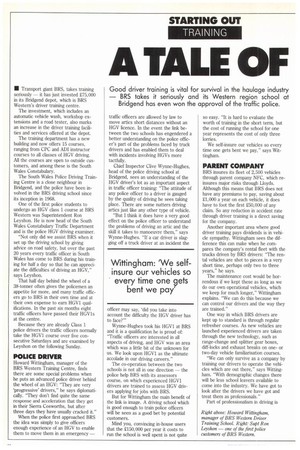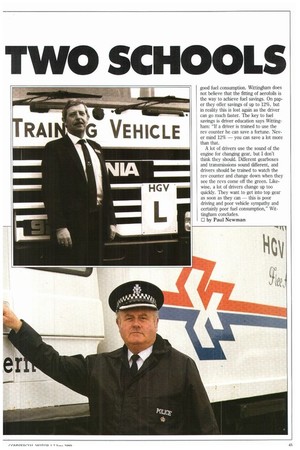A TAL OF TWO SCHOOLS
Page 48

Page 49

If you've noticed an error in this article please click here to report it so we can fix it.
Good driver training is vital for survival in the haulage industry — BRS takes it seriously and its Western region school at Bridgend has even won the approval of the traffic police.
• Transport giant BRS, takes training seriously — it has just invested 275,000 in its Bridgend depot, which is BRS Western's driver training centre.
The investment, which includes an automatic vehicle wash, workshop extensions and a road tester, also marks an increase in the driver training facilities and services offered at the depot.
The training department has a new building and now offers 15 courses, ranging from CPC and AD1 instructor courses to all classes of HGV driving. All the courses are open to outside customers, and among these is the South Wales Constabulary.
The South Wales Police Driving Training Centre is a close neighbour in Bridgend, and the police have been involved in the BRS driving school since its inception in 1968.
One of the first police students to undergo an HGV class 1 course at BRS Western was Superintendent Ron Leyshon. He is now head of the South Wales Constabulary Traffic Department and is the police HGV driving examiner.
"Not only did we assist BRS when it set up the driving school by giving advice on road safety, but over the past 20 years every traffic officer in South Wales has come to BRS during his training for half a day so that he can appreciate the difficulties of driving an HGV," says Leyshon.
That half day behind the wheel of a 38-tonner often gives the policemen an appetite for more, and many traffic officers go to BRS in their own time and at their own expense to earn HGV1 qualifications. In the past six months eight traffic officers have passed their HGVls at the centre.
Because they are already Class 1 police drivers the traffic officers normally take the HGV1 course over five consecutive Saturdays and are examined by Leyshon on the following Sunday.
POLICE DRIVER
Howard Wittingham, manager of the BRS Western Training Centre, finds there are some special problems when he puts an advanced police driver behind the wheel of an HGV: "They are very `progressive' drivers," he says diplomatically. "They don't find quite the same response and acceleration that they get in their Sierra Cosworths, but after three days they have usually cracked it."
When the police first approached BRS the idea was simply to give officers enough experience of an HGV to enable them to move them in an emergency — traffic officers are allowed by law to move artics short distances without an HGV licence. In the event the link between the two schools has engendered a better understanding on the police officer's part of the problems faced by truck drivers and has enabled them to deal with incidents involving HGVs more tactfully.
Chief Inspector Clive Wynne-Hughes, head of the police driving school at Bridgend, sees an understanding of the HGV driver's lot as an important aspect in traffic officer training: "The attitude of any police officer to a driver is gauged by the quality of driving he sees taking place. There are some nutters driving attics just like any other type of vehicle.
"But I think it does have a very good effect on the police officer to understand the problems of driving an attic and the skill it takes to manoeuvre them," says Wynne-Hughes. "If a car driver is slagging off a truck driver at an incident the officer may say, 'did you take into account the difficulty the HGV driver has to face?"
Wynne-Hughes took his HGV1 at BRS and it is a qualification he is proud of: "Traffic officers are interested in all aspects of driving, and HGV was an area which was a little bit of the unknown for us. We look upon HGV1 as the ultimate accolade in our driving careers."
The co-operation between the two schools is not all in one direction — the police help BRS with its assessors course, on which experienced HGV1 drivers are trained to assess HGV drivers applying for jobs with BRS.
But for Wittingham the main benefit of the link is image. A driving school which is good enough to train police officers will be seen as a good bet by potential customers.
Mind you, convincing in-house users that the 2150,000 per year it costs to run the school is well spent is not quite so easy. "It is hard to evaluate the worth of training in the short term, but the cost of running the school for one year represents the cost of only three lorries.
We self-insure our vehicles so every time one gets bent we pay," says Wittingham.
PARENT COMPANY
BRS insures its fleet of 2,500 vehicles through parent company NFC, which reinsures major risks through Lloyds. Although this means that BRS does not have any premiums to pay, saving about .21,000 a year on each vehicle, it does have to foot the first £50,000 of any claim. So any reduction in accident rate through driver training is a direct saving for the company.
Another important area where good driver training pays dividends is in vehicle sympathy. Wittingham sees the difference this can make when he compares the company's rental fleet with the trucks driven by BRS drivers: "The rental vehicles are shot to pieces in a very short time, perhaps only two to three years," he says.
The maintenance cost would be horrendous if we kept these as long as we do our own operational vehicles, which we keep for much longer," Wittingham explains. "We can do this because we can control our drivers and the way they are trained."
One way in which BRS drivers are kept up to standard is through regular refresher courses. As new vehicles are launched experienced drivers are taken through the new technology, such as range-change and splitter gear boxes, diff-locks and exhaust breaks on oneor two-day vehicle familiarisation courses.
"We can only survive as a company by training our drivers to operate the vehicles which are out there," says Wittingham. "With demographic changes there will be less school leavers available to come into the industry. We have got to look after the drivers we have got and treat them as professionals."
Part of professionalism in driving is good fuel consumption. Wittingham does not believe that the fitting of aerofoils is the way to achieve fuel savings. On paper they offer savings of up to 12%, but in reality this is lost again as the driver can go much faster. The key to fuel savings is driver education says Wittingham: "If a driver is trained to use the rev counter he can save a fortune. Never mind 12% — you can save a lot more than that.
A lot of drivers use the sound of the engine for changing gear, but I don't think they should. Different gearboxes and transmissions sound different, and drivers should be trained to watch the rev counter and change down when they see the revs come off the green. Likewise, a lot of drivers change up too quickly. They want to get into top gear as soon as they can — this is poor driving and poor vehicle sympathy and certainly poor fuel consumption," Wittingham concludes.
fl by Paul Newman


























































































































